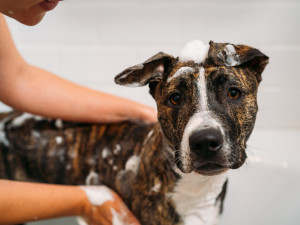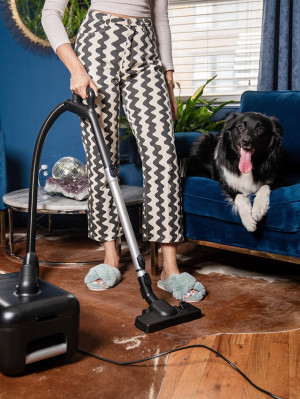How to Keep Your Pet Allergies in Check
While keeping your dog or cat at home where they belong.

Share Article
As a pet parent, you likely feel like your heart is walking around outside your body, like, all the time. You’re afraid of them getting sick, getting lost, getting hurt — the list is truly endless. Guess what! There’s actually something else you can worry about: finding out you have a pet allergy.
Your pet might classify this as more of a “you problem,” but suddenly finding that you may be allergic to your beloved dog or cat is a bit of a nightmare situation. Rehoming your best pal isn’t an option, but neither is sneezing every second you’re in your home. So…what exactly can you do?
Fortunately, there are plenty of solutions for pet parents with allergies to their animals, and many end up using a combination of strategies to live a more comfortable life with their pets. Payel Guptaopens in new tab, MD, FACAAI, assistant clinical professor at Mount Sinai Medical Center and SUNY Downstate Medical Center, says that pet parents should seek assistance from medical professionals and take advantage of available treatments.
“Any symptoms that are affecting a person’s quality of life should be evaluated and treated,” Dr. Gupta says. “We have effective treatments available, so no one needs to suffer.”
Kinship explored the available options that will help you treat your pet allergies without sacrificing your nightly appointment-TV snuggle with your furry pal.

Learn What Allergies You Have
First things first: Don’t be too quick to blame your pet for your allergies. While you may notice that you sneeze or get teary-eyed around your pet, it might not be because of their dander. The culprit could be an allergen they bring in on their fur from outside.
To understand the specific causes of your allergic reactions, you should visit your doctor for an allergy test. A specialist will test a wide variety of potential allergens on your skin to determine which ones cause a reaction. If it does turn out that you have a pet allergy, there are steps you can take to deal with your symptoms.
“Depending on your symptoms and how severe they are, there are many options for treatment,” Dr. Gupta says. “There are over-the-counter antihistamine pills, nasal sprays, and eye drops. As far as prescription options, there are strong medications available.”
Create a No-Allergy Area in Your Home
The most common advice for a pet allergy is the same for every allergen: Limit your exposure. But for pet parents, that just isn’t possible — and your dog certainly wouldn’t understand why you don’t spend as much time with them. Your cat, however, might be very fine with it, depending on their mood that day.
However, you can create an area of your home where your pet is not allowed, usually your bedroom, which is where you spend the most time. Use HEPA (high-efficiency particulate air) cleaners in this space to keep the air as clean as possible and frequently wash items, such as pillowcases and bedding, to remove any dander that could trigger your allergies.
Bathe Your Pet Regularly
Another way you can reduce your pet allergy symptoms is to bathe your pet around once a week. Regular bathing reduces the level of allergy-causing dander and can help you (literally) breathe a little easier.
If your pet doesn’t enjoy baths, look for ways to make the experience a little more fun. And be sure to talk to your veterinarian about the best shampoos to use on a weekly basis for your pet to keep from drying out their skin.
Keep Your Home Clean
An air-purifying system or HEPA air cleaners can help remove allergens from your home — not just pet dander, but mold, pollen, dust, and a variety of other airborne particles. If your symptoms are triggered by multiple allergens, air cleaners can be a big help when it comes to keeping your home comfortable.
In addition to air cleaners, take time to clean your home on a regular basis. That means washing cloth items, such as couch covers, blankets, and pet beds, as well as vacuuming carpets and rugs. You may even want to remove some items in your home that can easily catch pet dander, such as cloth curtains and blinds.
Use Over-the-Counter Medications
If your allergies are less severe, you may be able to get by with over-the-counter medications, such as nasal sprays or oral allergy medications. Antihistamines can help relieve sneezing, itching, and a runny nose, while corticosteroids (think Flonase and Nasonex) can help control your symptoms and reduce inflammation caused by allergens.
You may also want to try nasal irrigation, (using a Neti Potopens in new tab) to clear your nose and help you breathe more easily. Just make sure only to use contaminant-free water and rinse the device after each use.
Visit an Allergist
If all the home remedies aren’t doing it, it may be time to seek the help of a professional. Allergists, as their title implies, specialize in dealing with allergens and the symptoms they cause. They can recommend treatments, such as prescription medications, or simply help you find the right combination of nasal sprays and pills to alleviate your symptoms.
“Many times, I just help people properly use the medications they have,” Dr. Gupta says. “However, if you have asthma related to your allergies, you will need a prescription medication to help with your symptoms.”
An allergist may also recommend other strategies for controlling dander in your home, or, depending on your symptoms, more intensive treatment options in combination with medication, like immunotherapy (more on that below).
Try Immunotherapy
For some allergy sufferers, even the combination of a squeaky-clean home and a pile of medications from the local pharmacy won’t cut it. For severe allergy symptoms, an allergist may recommend immunotherapy, better known as allergy shots.
These shots are given to a patient every week or every other week to expose them to small doses of an allergen. The goal is to teach your immune system to be less sensitive, slowly reducing the allergen’s effect over time. If the shots are effective, you will eventually only need maintenance shots every month or so.
Hilary Weaver, senior editor at Kinship, started taking allergy shots in December 2021, after learning that she had an allergy to her dogs’ dander. “My allergist and I talked through a plan, and he started me out on an incredibly low dose,” she says. “I’ve been slowly building up from there.”
While she didn’t notice a difference in her symptoms right away, after about eight months on immunotherapy, Weaver saw a huge improvement in her allergy.
“I have far fewer ‘bad days’ than before I started the shots,” she says. “I will say that I’ve combined the shots with general maintenance around my allergies: vacuuming on a schedule with a quality vacuum, washing my bedding in hot water more frequently, and sleeping in a dog-free room when needed.
When it comes to battling your pet allergy, you’re likely going to need to take a multi-part approach. Your combo of solutions will need to be specific to you, but ditching quality time with your pet does not need to be one of them.

Savannah Admire
Savannah Admire is a writer and pet mom to two dogs and a cat. Under the name Savannah Cooper, she has published poetry in 40 different publications, as well as a poetry book, Mother Viper (2025). When she’s not writing, you can find her reading, taking photos, or volunteering as a content creator for her local community theatre. As a pets writer, she focuses on cat and dog behavior and pet parenthood. She currently lives in Western Maryland.
Related articles
![Winterizing your dog's coat - Dog laying in the snow.]()
Natural Remedies for Dry Skin: How to Help Dry Skin on Dogs
Spoiler: These at-home remedies are probably already in your pantry.
![a Chihuahua dog licking their paw]()
Why Do Dogs Lick Their Paws?
Their toes might smell like Fritos, but there’s no way they taste that good.
![puppy scratching fleas, get rid of fleas on dogs]()
How to Get Rid of Fleas — Proven Home Remedies
You can stop your home from becoming a literal flea circus.









